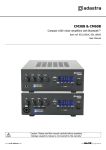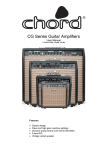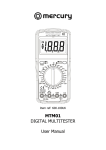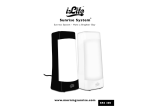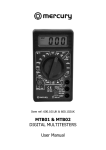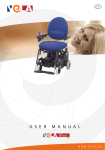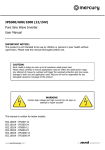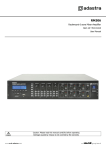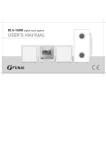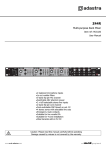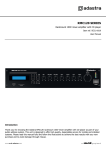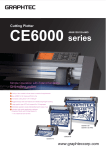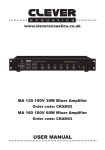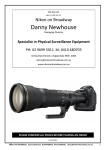Download CM/CS SERIES - Sound Services
Transcript
CM/CS SERIES Compact 100V amplifiers Item ref: 953.100UK, 953.101UK, 953.102UK User Manual CM/CS Series User Manual Caution: Please read this manual carefully before operating Damage caused by misuse is not covered by the warranty Introduction Thank you for choosing the Adastra CM/CS-series compact 100V amplifier as part of your public address system. This amplifier is designed to offer high quality, dependable service for mobile and installed systems. Please read this manual fully and follow the instructions to achieve the best results with your new purchase and to avoid damage through misuse. Warning To prevent the risk of fire or electric shock, do not expose any components to rain or moisture. If liquids are spilled on the casing, stop using immediately, allow unit to dry out and have checked by qualified personnel before further use. Avoid impact, extreme pressure or heavy vibration to the case No user serviceable parts inside – Do not open the case – refer all servicing to qualified service personnel. Safety Check for correct mains voltage and condition of IEC lead before connecting to power outlet Use double insulated speaker wire with adequate current rating for 100V speaker connections Do not use 8Ω and 100V terminals at the same time Do not allow any foreign objects to enter the case or through the ventilation grilles Placement Keep out of direct sunlight and away from heat sources Keep away from damp or dusty environments For rack-mounting, use an appropriate shelf unit (e.g. 853.055UK) and ensure adequate support Ensure adequate air-flow and do not cover cooling vents at the front and rear of the amplifier Ensure adequate access to controls and connections Cleaning Use a soft cloth with a neutral detergent to clean the casing as required Use a vacuum cleaner to clear ventilation grilles of any dust or debris build-ups Do not use strong solvents for cleaning the unit CM/CS Series User Manual Front panel 1. Microphone input jack (+ XLR CM60) 2. MIC volume control 3. LINE IN volume control 4. USB/SD volume control 5. MASTER volume control 6. FOG button 7. SIREN button 8. ALERT button 9. VU meter 10. USB/SD audio player 11. POWER switch 12. Mains voltage switch 13. IEC mains inlet & fuse holder 14. DC power terminals 15. COM speaker terminal 16. 8Ω speaker terminal 17. 100V speaker terminal 18. LINE OUT connectors (RCA) 19. LINE IN connectors (RCA) Rear panel CM/CS Series User Manual Connection and setup Connect the rear IEC inlet (13) to the mains using the supplied mains lead (or an equivalent approved type). Ensure that the voltage is correct as indicated on the voltage selector (12) and that the mains outlet is switched on. Alternatively, the amplifier can be powered by a 12V battery, such as a car or boat battery, by connecting the “+” and “-” of the battery to the 12Vdc INPUT (14) on the rear panel. Note: Ensure that DC cables are capable of handling the current (6A min. recommended) Connecting CS series slave amplifiers For CS series slave amplifiers, connect the audio input to the LINE IN connectors (19) on the rear panel using good quality RCA leads. The CS series amplifiers are mono, so any stereo signals will be summed together and reproduced as a single output. The signal maybe continued onto further amplifiers by connecting the LINE OUT connectors (18) to the LINE IN connectors of the next amplifier, again using good quality RCA leads. Connecting CM series mixer-amplifiers For CM-series mixer amplifiers, connect any line level audio inputs to the LINE IN connectors (19) on the rear panel using good quality RCA leads. Connect a microphone (if required) to the front panel jack or combo input (1). Further amplifiers can be connected from the rear LINE OUT sockets. The CM and CS series amplifiers can be used either as 100V line amplifiers or standard low impedance power amplifiers. These 2 configurations cannot be used together, so it is important to decide which method will be used at the start. Information about the differences between 100V and low impedance systems are detailed on the following pages. CM/CS Series User Manual 100V line systems For 100V line systems, connect the amplifier to the first speaker in the system using double-insulated speaker wire which has adequate current rating to handle the total output of the amplifier. Connect the “100V” (17) output terminal to the positive (+) connection of the speaker and “COM” output (15) to the negative (-) connection of the speaker. Connect further speakers in parallel to the first speaker with all positive terminals and connected together and all negative terminals connected together as shown below. A 100V line speaker system can comprise of many speakers connected together. The determining factor for how many speakers can be used on a single amplifier is the power rating. For most purposes, it is advised to connect as many speakers as needed with a combined wattage of no more than 90% of the amplifier’s output power rating. The terminals of a 100V speaker are connected to a transformer and in some cases, this transformer may be “tapped” for different power ratings. These tappings can be used to adjust the wattage (and output volume) of each speaker in the system to help achieve the ideal total power of the system for the amplifier. Low impedance systems The CM and CS series amplifiers can provide an output for a single 8Ω speaker by connecting the “8Ω” output (16) to the positive (+) speaker connection and “COM” output (15) to the negative (-) speaker connection. It is important to ensure that the speaker load is no less than 8Ω and that the power handling of the speaker is equal to or greater than the output power of the amplifier. CM/CS Series User Manual Operation When all connections to the amplifier are made, turn all rotary controls down and switch on the power (11) and a power LED will illuminate. Ensure a signal is being fed to the LINE IN connection and gradually increase the MASTER rotary control (5) part way for testing. For CM mixer-amplifiers, increase the LINE IN rotary (3) until the output is heard through the speakers. Turn up the MASTER to the maximum required volume level and reduce the LINE IN control if necessary. Note: If a line input is not connected to a CM series mixer-amplifier, the initial test can be made using the built-in USB/SD audio player. See “USB/SD audio player“ section below for instructions. If a microphone is connected, make sure it is switched on and gradually increase the MIC control (2) whilst speaking into the microphone until the required volume level is reached. Note: The microphone should not be able to “hear” the speakers, which can cause feedback (squealing or howling noise). Fog/Siren/Alert buttons In addition to audio controls, the CM60 front panel has 3 warning sound buttons. Pressing any of these will issue one of 3 preset warning sounds through the speakers. Powering down After use, turn down rotary level controls before disconnecting input leads. To avoid loud pops through the speakers, turn down the MASTER control before powering down. CM/CS Series User Manual USB/SD audio player 1. USB / SD input source selector 2. REPEAT button (repeat or random play) 3. USB port: accepts USB storage device 4. EQ select: step through 5 different presets 5. SD CARD INPUT 6. Previous track or volume decrease 7. Play / Pause track 8. Next track or volume increase 9. LED digital display CM series mixer-amplifiers are fitted with a built-in USB/SD audio player. This unit allows playback of music or audio messages which are stored as standard compressed audio files on either USB pen drive or SD card. Push a USB pen drive into the USB port (3) and/or SD card into the SD card input (5) and the audio files will start to play automatically. Turn up the USB/SD rotary control gradually to hear the output from the speakers and increase to the required level. If play does not start automatically, press the USB/SD button (1) and Play/Pause button (7) to check if the player is set to play from the required memory device. Try Previous track and Next track buttons (6, 8) if the selected track is unable to play. Otherwise, check that the audio files are of a standard compressed type. The USB/SD button (1) switches between the USB memory device and SD card, allowing a choice of playlist and storage type. Normal playback will read through all tracks on the storage device. Press the REPEAT button (2) once to continually repeat the current track, press REPEAT again to enter the random track selection mode. Pressing the EQ button (4) steps through 5 preset equalizer settings, offering different tonal responses to suit the type of music or compensate for room acoustics. Pressing the Previous track button (6) briefly steps backwards through tracks on the memory device. Press and hold this button to decrease the playback volume. Pressing the Next track button (8) briefly steps forwards through tracks on the memory device. Press and hold this button to increase the playback volume. To pause the current track, press the Play/Pause button (7) and press it again to resume playback. The LED digital display (9) will show the track number when a track is selected and then the elapsed time when it is playing. Note: The USB pen drive and SD card will protrude from the front panel when inserted, so removing these after use can help to avoid damage to them. CM/CS Series User Manual Specifications Power supply Output power DC power Outputs: Speaker Output: Line Inputs Controls Audio source USB/SD player controls Warning sounds THD Dimensions Weight CM30 CM60 110/230Vac, 50/60Hz (IEC) 30Wrms 60Wrms 12Vdc option (screw terminals) 100V / 8 Ohm / COM terminals RCA signal output Microphone (6.3mm jack) & line (RCA) Mic, line, USB/SD, master volume Integral USB/SD digital audio player USB/SD, repeat, EQ, rev/-, play/pause, forward/+ N/A Fog / Siren / Alert <1.0% 329 x 210 x 84mm 3.76kg 4.82kg CS60 60Wrms Line (RCA) Master volume N/A N/A N/A 4.72kg Troubleshooting No power LED on control panel Power LED is on but no other LEDs and no output Power light and output LEDs lighting but no output USB/SD player will not play audio from media Output is very loud or distorted Output is working but at very low level Feedback from microphone Amplifier overheating Ensure IEC lead is in good condition and connected properly If 12Vdc power input is being used, check battery is charged Check mains inlet fuse Ensure POWER switch is on Check input signals and condition of input connection leads Check MASTER, MIC, LINE IN or USB/SD controls are turned up Check speaker output terminals are connected correctly Check speakers are working (test on another amp if available) Press PLAY on transport controls Check memory device is connected properly (remove and re-insert) Check file types – standard compressed digital audio files required Check memory device works on a PC or Mac for standard playback Check level of input signal is not too high Reduce MIC, LINE IN, USB/SD and/or MASTER level Ensure Hi-Z line level input(s) not connected via MIC input Check input audio source level is not too low Increase MIC, LINE IN, USB/SD and/or MASTER level Check for quiet recording of media files on USB Face microphone away from speakers and monitors Turn down MIC and/or MASTER level Ensure cooling vents are clear from debris and dust Check that 4Ω or 8Ω speakers are not connected to 100V terminals Ensure total 100V speaker wattage is lower than amplifier rating Ensure that 100V and 8Ω speakers are not both connected Ensure that total load connected to 8Ω output is not less than 8Ω Disposal: The “Crossed Wheelie Bin” symbol on the product means that the product is classed as Electrical or Electronic equipment and should not be disposed with other household or commercial waste at the end of its useful life. The goods must be disposed of according to your local council guidelines. Errors and omissions excepted. Copyright© 2014. AVSL Group Ltd. CM/CS Series User Manual








